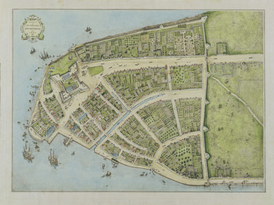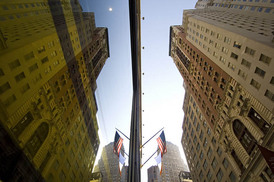Wall Street
A gang of black men labored as long as daylight allowed, digging a three-foot-deep trench from the East River all the way across Manhattan Island to the Hudson River. The trench followed a rough path that ran along the north edge of the village. It was March 1653, and Governor Stuyvesant had been sent orders to fortify New Amsterdam. English warships were gathering in Boston Harbor, readying to sail south and take the Dutch colony.
The men digging the trench had names such as Paulo d’Angola, Simon Congo, and Anthony Portuguese. As their names showed, many were Africans who had worked aboard Spanish or Portuguese ships before the Dutch seized them. These Africans were owned by the Dutch West India Company, but some had gained a form of half-freedom. They worked for themselves, but owed the company labor whenever needed. Half-free or enslaved, they could own property, testify in court, bear arms in emergencies, attend church, and marry. But their children were not free.
When the Africans finished the trench, they formed a wall by standing big logs into it. Each log was 18 inches around and 12 feet long. Then they pounded dirt and stones back into the trench around the base of each log to make the wall strong. They built blockhouses at the ends of the wall, and gates were added where roads ran through it. But as soon as the wall was finished, it was no longer needed. The Netherlands and England had signed a peace treaty. However, the wall built by the Africans gave the rough path that eventually became a street with a new name—Wall Street.
This entry contributed by
Curriculum Concepts International
Related Media
Video

|
Columbia University History Professor Kenneth Jackson describes the construction of Wall Street.
|
Images

|
The wall became Wall Street, which is now the financial capital of the world. Up until the Civil War and long after slavery in New York was illegal, Wall Street firms profited from the slave trade.
|

|
In 1653, Africans built a wall along the northern edge of New Amsterdam to protect the Dutch community from the English. It stretched from the Hudson River clear across the island to the East River.
|

|
This drawing shows a section of the Wall Street palisade as it stood in the 1600s.
|






